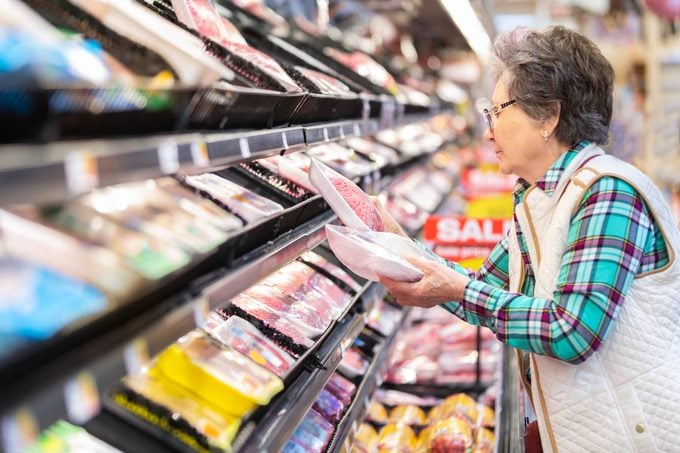Inflation may be starting to decrease, but experts still expect grocery prices to increase 7.5% in 2023. Follow these tips for a budget grocery list to get the most for your money.

Budget Grocery List: 60+ Foods That’ll Keep Your Grocery Bill Low

Last year, shoppers across the country paid 12% more for the food they ate at home. And according to the United States Department of Agriculture (USDA), experts predict that all food prices in the U.S. will rise by 7.5% this year.
When you have to spend more to feed your family, there’s less money left over to cover the cost of everything else. Unfortunately, there isn’t anything you can do about the prices you face at the grocery store. Yet there are grocery shopping habits you can change to save money, and a budget grocery list can be a great place to start.
Keep in mind that grocery shopping on a budget doesn’t mean you should always look for the cheapest items at the store. Spending a little more money on filling, nutrient-filled foods is often the smarter and more financially savvy choice in the long run.
Below are our best budget grocery list ideas, broken down into six easy-to-follow categories, to make your next shopping trip a little easier (and hopefully a lot more affordable).
Produce
Between rising prices and a shorter shelf life, saving money on fresh fruits and vegetables can be a challenge. But if you use smart shopping strategies like buying produce with a longer shelf life, shopping for in-season fruits and veggies, or shopping at affordable retailers (like salvage grocery stores), there are plenty of opportunities to save.
Fruits
- Longer Shelf Life: Apples, Blueberries, Blackberries, Cherries, Lemons, Oranges, Tomatoes, Watermelon
- Spring Season: Avocado, Strawberries, Pineapples, Apricots
- Summer Season: Peaches
- Fall Season: Grapes, Pears, Kiwi
- Winter Season: Grapefruit
Vegetables
- Longer Shelf Life: Broccoli, Carrots, Cucumbers, Garlic, Lettuce, Onions, Potatoes, Mushrooms
- Spring Season: Asparagus, Artichokes
- Summer Season: Green Beans, Zucchini, Summer Squash, Eggplant
- Fall Season: Swiss Chard, Turnip Greens, Sweet Potatoes, Brussels Sprouts
- Winter Season: Winter Squash, Pumpkins, Leeks
Meats and Meat Alternatives

For many shoppers, meat and meat alternatives represent one of the most expensive categories in their food budget. Buying meat in bulk from a meat supplier or your favorite warehouse store are potential ways to save some cash at the grocery store. And cooking recipes with ground beef or your preferred ground protein (e.g., turkey or chicken) could also help keep your grocery budget under control.
Opting for more affordable meat selections could help keep your costs down as well, but you may need to try some tricks to get cheap meat to taste expensive, like slow cooker recipes or marinating your cuts to make them more tender. Opt for these cheaper cuts of meat:
- Flank Steak
- Bottom Sirloin
- Short Rib
- Chuck Roast
- Pork Butt
- Lamb Shoulder
Seafood
The cost of certain seafoods, like the cost of produce, may also ebb and flow based on the season. Factors like weather and global supply and demand can play a big role in seafood prices as well. But if you’re looking for ways to build a budget grocery list, consider shopping in season for the following seafood items to potentially save money and unlock the freshest flavors for your favorite seafood recipes.
Fish
- Spring Season: Bluefin Tuna
- Summer Season: Salmon, Cod (Atlantic), Bluefish, Striped Bass, Albacore Tuna
- Fall Season: Halibut
- Winter Season: Cod (Pacific), Skate, Monkfish
Shellfish
- Spring Season: Soft Shell Crabs
- Summer Season: Maine Lobster
- Fall Season: Scallops, Blue Crabs, Snow Crabs
- Winter Season: Stone Crabs, Dungeness Crabs
Note that many fisherman will use modern flash freezing technology on a portion of their catch right on the boat. As a result, the seafood quality remains very high, but the prices of this frozen seafood can be a lot more affordable for budget-conscious shoppers.
Eggs, Dairy and Dairy Alternatives
The soaring price of eggs made headlines and was the subject of countless memes and social media videos in recent months. Yet even though the cost of eggs is finally coming down again, it still costs shoppers 55% more to buy a dozen eggs than it did a year ago.
If you’re searching for money-saving options for eggs, dairy or dairy alternatives for your budget grocery list, here are a few options to consider:
- Shop sales: There are even convenient grocery store apps that can make deal-hunting in your area a lot easier.
- Substitute eggs for meat: Cooking egg recipes instead of meat recipes, even a few times a week, could be a creative way to lower your grocery costs.
- Buy in bulk: You can often find dairy, dairy alternatives and eggs at a cheaper price if you’re willing to buy these items in bulk at Sam’s Club, Costco or your favorite warehouse store.
Pantry Staples

Some of the best ways to save on your budget grocery list involve stocking your shelves with affordable pantry staples and creating tasty recipes from these items. If you have the time and inclination, you could even try your hand at making pantry staples at home to supercharge your savings.
Here are some ideas on how to stock your pantry on a budget:
- Purchase in bulk when shopping for items with a long shelf life (e.g., oatmeal, rice, beans, legumes, dried pasta, coffee)
- Shop after-season sales (but pay attention to expiration dates).
- Use coupons to stretch your dollars.
- Opt for store brand instead of brand name products when possible.
Frozen Foods
In general, frozen foods cost less compared to their fresh counterparts. So when you add frozen foods to your budget grocery list, you can often reduce costs and extend the shelf life of the items you purchase at the same time. If you’re able to store the food you purchase in a deep freezer (at 0°F), your food could last indefinitely, according to FoodSafety.gov, although the quality may degrade over time.
Here are some frozen foods to purchase, either in bulk or when they’re on sale:
- Meats (like poultry and seafood)
- Vegetables (spinach, carrots, peas, green beans, corn, etc.)
- Berries
- Frozen Meals
Bottom Line
It can be frustrating to face higher prices at the grocery store, especially when your budget is tight. But if you use some of the strategies above to build your budget grocery list, it’s still possible to lower your food costs in creative ways without sacrificing on flavor in the process. Before you move ahead, get to know about the cheapest grocery store in America.




















